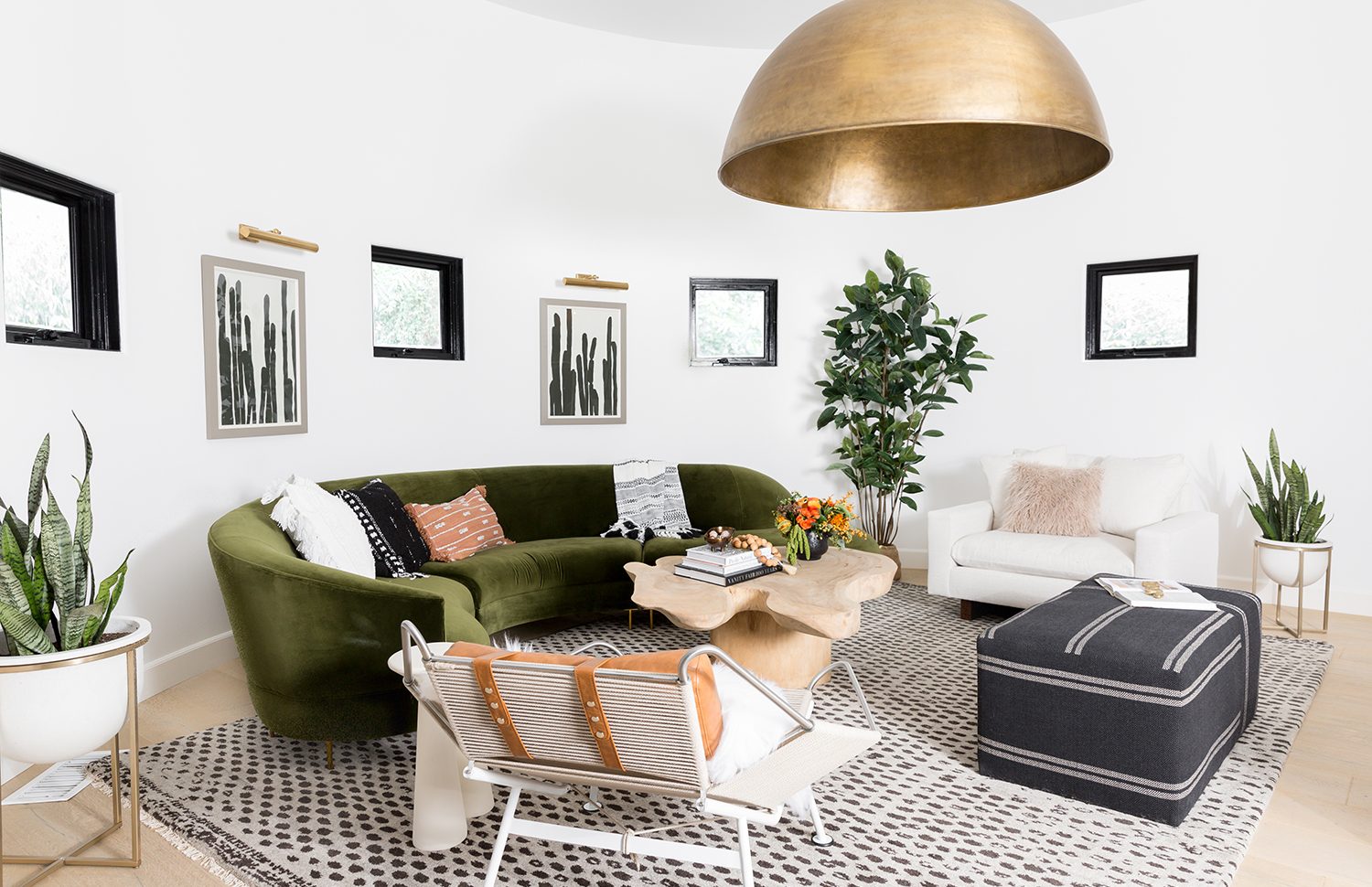Okay, so you’ve got that slightly off-kilter window in your bedroom. It’s not centered, it’s a little unexpected, but it has the potential to become your bedroom’s most charming feature. This guide will show you how to style your furniture and decor to create a balanced and beautiful space, even with an unconventional window.
Embracing the Offbeat: Design Strategies for Asymmetrical Windows
Asymmetrical windows present a unique opportunity to create a truly distinctive bedroom. Instead of viewing them as a design challenge, consider them a unique characteristic that adds personality. The key is to work with the asymmetry, not against it, to achieve a harmonious and inviting atmosphere.
Layout: Positioning Your Bed and Furniture
Where do you begin with an asymmetrical window? Start with your bed, the largest piece of furniture. While centering it on the wall often provides a sense of stability, consider experimenting with off-center placement, perhaps closer to the window, to enhance the asymmetry and make it a deliberate design choice. [https://www.wavesold.com/]
After deciding on the bed’s location, arrange your other furniture. If your window is on one side, a larger dresser or wardrobe on the opposite wall can counterbalance it. Alternatively, if you have a great view, position a comfy armchair near the window for a cozy reading nook, making the window a focal point.
Window Treatments: Framing and Balancing
Window treatments can soften the asymmetry, control light, and add personality. Floor-length curtains on either side can create symmetry. Alternatively, play up the asymmetry with different lengths or textures on each side—sheer curtains on one side and a Roman shade on the other, for example. Don’t be afraid to mix and match blinds and curtains. [https://www.wavesold.com/]
Décor and Accessories: The Finishing Touches
Decorative elements are the finishing touches that complete the room. A strategically placed mirror can reflect light, enlarge the room, and balance the asymmetry. A gallery wall opposite the window can draw the eye and create a focal point. Rugs can anchor the space and define different zones. Experiment with textures, colors, and patterns to celebrate your asymmetrical window.
Light and Views: Enhancing Natural Light
Asymmetrical windows often bring in natural light in unique ways. Maximize this with light-colored walls and furniture. Arrange your furniture to make the most of the view. A well-placed floor lamp can brighten any darker corners, creating a balanced ambiance.
Navigating Challenges: Uneven Light and Perceptions
Asymmetrical windows can present challenges, such as uneven light distribution, easily addressed with lamps and mirrors. Some may perceive asymmetry as a flaw, but thoughtful placement and décor can transform it into a striking design feature. These “challenges” often lead to creative and personalized solutions. Some designers even suggest that unusual window placements encourage more creative interior design choices, resulting in extraordinary spaces.
Beyond Bare Walls: Creative Ideas to Transform Your Bedroom
Let’s explore how to elevate your bedroom walls from simple to stunning. We’ll delve into creating a space you truly love.
Texture: Adding Depth and Dimension
Texture brings walls to life. Think of a woven tapestry, a gallery wall with varied frames, or faux brick panels. These elements add depth and personality. It’s like adding spices to a dish—a pinch of texture can transform the room’s flavor.
Artful Arrangements: Showcasing Your Style
Artwork infuses personality. Consider a salon-style hang—a curated collection of prints, photos, postcards, or even small framed objects. Mix and match frame styles and sizes. Think outside the box! A framed scarf, vintage fabric, or pressed botanicals add unexpected charm.
Mirrors: Light and Space Enhancers
Strategically placed mirrors bounce natural light, making your bedroom feel brighter and more spacious. A large, ornate mirror can be a statement piece, while a grouping of smaller mirrors creates a playful vibe. They add subtle magic as sunlight dances off their surfaces.
Shelves: Displaying Treasures
Shelves are both practical and stylish. Floating shelves create a modern look, perfect for plants, books, or decorative objects. Reclaimed wood shelves add warmth and character. They’re a great way to incorporate different textures and materials.
Textiles: Warmth and Pattern
Textiles add warmth, color, and personality. A vibrant tapestry can transform a wall. A patterned throw over your headboard adds bohemian charm. Textiles are like wearable art for your walls, introducing texture, color, and a cozy feel.
DIY Projects: The Personal Touch
The most meaningful decor is often handmade. A stenciled wall, a small hand-painted mural, or a macrame piece adds a personal touch. It’s like adding your signature, making the space truly your own.
Lighting: Mood and Accentuation
Lighting creates atmosphere. Soft, warm light accentuates artwork and creates a cozy ambiance. Sconces add elegance and reading light. String lights create a whimsical feel. Lighting is the conductor of your bedroom orchestra.
Color: Setting the Tone
Color profoundly impacts mood. A rich accent wall adds drama, while soft pastels create serenity. Choose colors that resonate with you, setting the desired atmosphere.
Budget-Friendly Decorating: Creative Savings
Transforming your bedroom doesn’t require a fortune. Repurposing old frames, creating artwork, or rearranging furniture can make a big difference. It’s like a treasure hunt—rediscovering hidden gems you already own.
| Element | Impact | Examples |
|---|---|---|
| Texture | Adds depth and visual interest | Woven tapestries, faux brick panels, textured wallpaper |
| Art | Infuses personality and creates focal points | Gallery walls, framed prints, DIY art, framed textiles |
| Mirrors | Amplifies light and expands space | Large statement mirrors, groupings of smaller mirrors |
| Shelves | Displays treasures and adds visual interest | Floating shelves, reclaimed wood shelves, built-in shelves |
| Textiles | Adds warmth, color, and pattern | Tapestries, throws, patterned curtains |
| DIY Projects | Adds personal touch and creative expression | Stenciled walls, hand-painted murals, macrame |
| Lighting | Sets the mood and highlights decor | Sconces, string lights, table lamps |
| Color | Influences mood and creates atmosphere | Accent walls, pastel palettes, bold color pops |
This information offers general knowledge and inspiration. Interior design constantly evolves, and ongoing research may bring new trends. While we aim to provide helpful suggestions, consulting a professional designer for personalized advice is always recommended. [https://www.wavesold.com/autograph-plant] [https://www.wavesold.com/baby-bed-bug]
Mastering the Off-Center Window: Design Tricks for Hiding It Behind Your Bed
Let’s address that slightly awkward window behind your bed. It might seem like a design dilemma, but it’s a chance to get creative. We’ll explore practical solutions, from simple décor tricks to furniture arrangements, to achieve your perfect bedroom aesthetic.
The Art of Camouflage: Strategic Furniture Placement
Use furniture for strategic concealment. Tall bookshelves flanking the window create a visual barrier and offer storage. A stylish room divider offers subtle separation and adds elegance. A well-placed dresser subtly obscures the window while providing functionality.
Headboard Magic: Creating a Focal Point
A wide headboard extending beyond the bed acts as a visual anchor, balancing an off-center window. A tall headboard enhances this effect, minimizing the window’s impact.
Curtain Creativity: Blending and Balancing
Curtains and blinds can be masters of disguise. Extending curtains beyond the frame creates width and symmetry. Matching curtain and wall colors makes the window recede. Two separate curtain panels create balance.
Decor Distraction: Shifting the Focus
Draw attention elsewhere. A gallery wall above the bed creates a focal point. A large mirror reflects light, adds depth, and serves as a captivating distraction. A tapestry, artwork, or bold paint color on the opposite wall can similarly shift the focus.
Illusory Enhancements: Mirrors and Perception
Strategically placed mirrors can create the illusion of another window, balancing asymmetry and adding depth. They reflect light and other elements, making the room feel larger and more balanced, minimizing the off-center window’s effect.
Tailoring to Your Taste: Finding the Right Solution
There’s no one-size-fits-all solution. The best approach depends on your style, room size, and window placement. A combination of techniques might work best. Experiment with different ideas to find what suits your space.
| Technique | Description |
|---|---|
| Camouflage | Use furniture like bookshelves, room dividers, or dressers to subtly obscure the window. |
| Headboard Strategy | Choose a wide, tall headboard to act as a visual anchor and draw the eye away from the window. |
| Curtain Illusion | Extend curtains beyond the window frame and match them to the wall color to create a seamless blend. |
| Décor Distraction | Use wall décor, mirrors, or a bold paint color to create a focal point elsewhere in the room. |
| Mirror Magic | Strategically place a mirror to create the illusion of another window, balancing the asymmetry. |
“Hiding” a window is often about creating balance and harmony. It’s about using design elements strategically. With creativity, you can turn a potential challenge into a stylish triumph.
Is One Window Enough for a Bedroom? Light, Ventilation, and Design Considerations
Let’s explore the nuances of single-window bedrooms and how to make them work beautifully.
Legality and Safety: Essential Regulations
Every bedroom legally needs a window for safety (fire escape) and fresh air circulation. Building codes specify minimum window sizes (often around 24×36 inches) for ventilation and light. Always check local regulations. While one window might suffice legally, there are other comfort and design factors to consider.
Light and Ventilation: Finding the Right Balance
Can a single window provide sufficient light and ventilation? It probably can if strategically positioned and sized correctly. Larger or multiple windows undoubtedly offer better airflow and light, impacting the room’s feel. A single, well-placed window can likely achieve balance, but more windows enhance the effect.
Design and Aesthetics: Optimizing a Single Window
A single, possibly off-center, window presents design opportunities. Consider furniture placement. A mirror can bounce light and create spaciousness. Lighter wall colors amplify brightness. Working within limitations can spark innovative solutions.
Beyond Natural Light: Layering Illumination
If your window provides insufficient light, layered lighting can transform your space. Ambient lighting provides overall illumination, task lighting for activities, and accent lighting highlights décor. A floor lamp’s soft glow, a focused reading light, and a stylish pendant create a warm ambiance.
The Psychology of Light: Impact on Well-being
Natural light profoundly impacts well-being, influencing mood, sleep, and productivity. A bright room energizes, while dim light promotes relaxation. Consider the psychological impact of your window. Research suggests a strong link between natural light and mental health, an area of ongoing study.
Energy Efficiency: Smart Choices
With rising energy costs, choose windows and coverings wisely. A well-insulated window reduces heat loss in winter and keeps your room cool in summer. Stay up-to-date on advancements in window technology.
Design Inspiration: Single-Window Wonders
Browsing images of well-designed single-window bedrooms can inspire you. From minimalist to bohemian, countless examples demonstrate how a single window can be a stunning focal point.
| Feature | Single Window Considerations | Multiple Window Advantages |
|---|---|---|
| Natural Light | Strategize placement & size; enhance with mirrors & light colors | Abundant natural light; less reliance on artificial sources |
| Ventilation | Ensure adequate size for airflow; consider placement for cross-breeze | Improved airflow and air quality |
| Design | Opportunity for creative furniture placement & décor | More flexibility in furniture arrangement; balanced light |
| Energy Efficiency | High-quality insulation crucial | Potential for greater heat loss/gain; individual control |
| Psychological Impact | Can still be positive with thoughtful design | Enhanced connection with outdoors; potential for brighter mood |
A single window can suffice, fulfilling legal requirements and basic needs. Multiple windows offer advantages in light, ventilation, and design flexibility. Ultimately, a single window’s “enoughness” depends on individual preferences, room layout, and a thoughtful approach to design and functionality. Ongoing research continues to explore the complex interplay between natural light, human well-being, and architectural design.
- Burning Plastic Smell in House: Causes, Solutions, and Safety Measures - April 8, 2025
- Best Bug Killer for Yard: Effective Pest Control Guide (2024) - April 8, 2025
- Brown Recluse Spider Bites: Identification, Treatment, and Prevention - April 8, 2025










